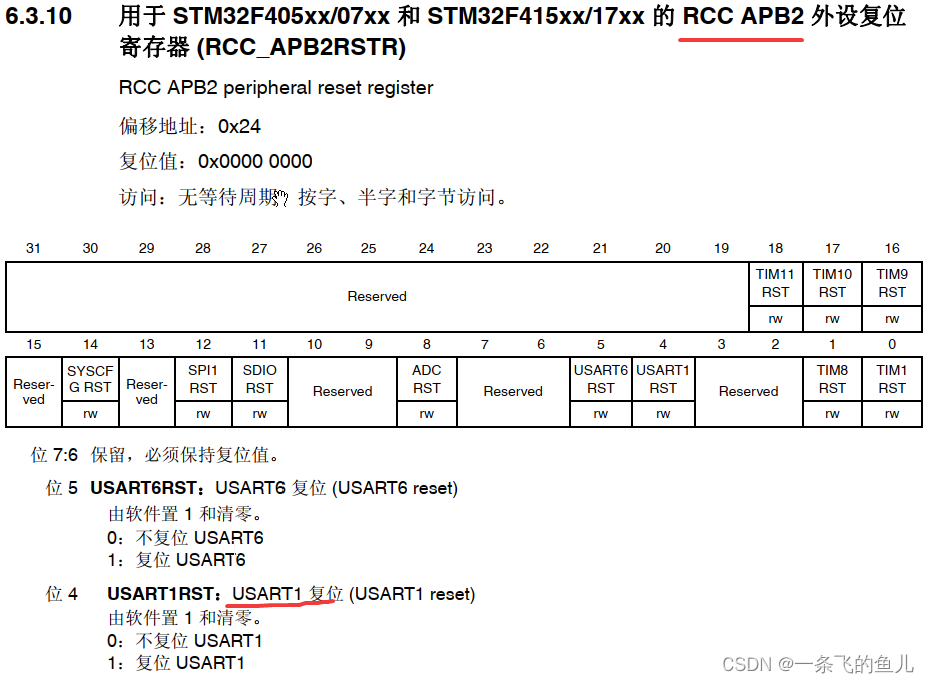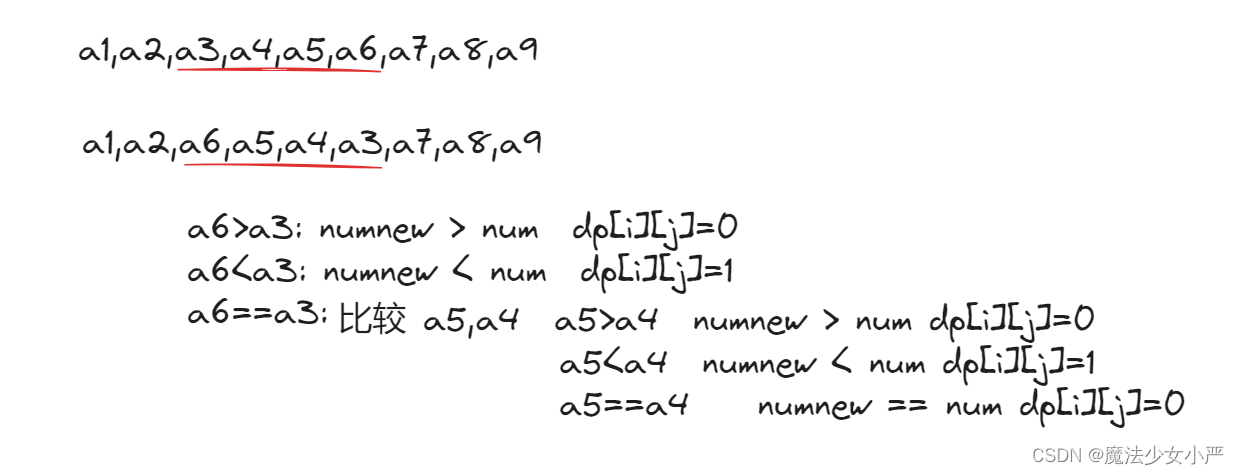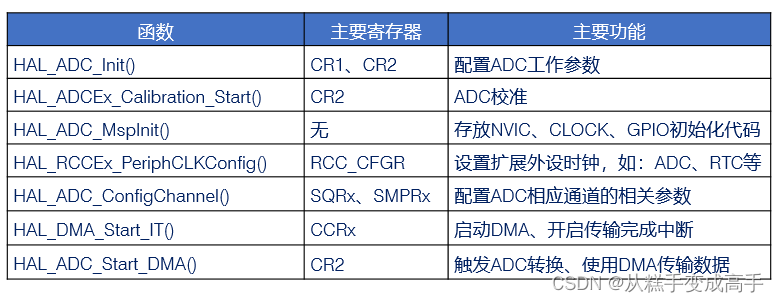目录结构
注:提前言明 本文借鉴了以下博主、书籍或网站的内容,其列表如下:
1、参考书籍:《PostgreSQL数据库内核分析》
2、参考书籍:《数据库事务处理的艺术:事务管理与并发控制》
3、PostgreSQL数据库仓库链接,点击前往
4、日本著名PostgreSQL数据库专家 铃木启修 网站主页,点击前往
5、参考书籍:《PostgreSQL中文手册》
6、参考书籍:《PostgreSQL指南:内幕探索》,点击前往
7、深度解析 PostgreSQL Protocol v3.0(一),点击前往
8、技术贴 | 深度解析 PostgreSQL Protocol v3.0(二)— 扩展查询,点击前往
1、本文内容全部来源于开源社区 GitHub和以上博主的贡献,本文也免费开源(可能会存在问题,评论区等待大佬们的指正)
2、本文目的:开源共享 抛砖引玉 一起学习
3、本文不提供任何资源 不存在任何交易 与任何组织和机构无关
4、大家可以根据需要自行 复制粘贴以及作为其他个人用途,但是不允许转载 不允许商用 (写作不易,还请见谅 💖)
5、本文内容基于PostgreSQL master源码开发而成
深入理解PostgreSQL数据库之Protocol message构造和解析逻辑
- 文章快速说明索引
- 功能使用背景说明
- 功能实现源码解析
- 辅助调试信息
- 前端信息构造
- 后端消息解析

文章快速说明索引
学习目标:
做数据库内核开发久了就会有一种 少年得志,年少轻狂 的错觉,然鹅细细一品觉得自己其实不算特别优秀 远远没有达到自己想要的。也许光鲜的表面掩盖了空洞的内在,每每想到于此,皆有夜半临渊如履薄冰之感。为了睡上几个踏实觉,即日起 暂缓其他基于PostgreSQL数据库的兼容功能开发,近段时间 将着重于学习分享Postgres的基础知识和实践内幕。
学习内容:(详见目录)
1、深入理解PostgreSQL数据库之Protocol message构造和解析逻辑
学习时间:
2024年04月17日 22:14:16 星期三
学习产出:
1、PostgreSQL数据库基础知识回顾 1个
2、CSDN 技术博客 1篇
3、PostgreSQL数据库内核深入学习
注:下面我们所有的学习环境是Centos8+PostgreSQL master+Oracle19C+MySQL8.0
postgres=# select version();
version
------------------------------------------------------------------------------------------------------------
PostgreSQL 17devel on x86_64-pc-linux-gnu, compiled by gcc (GCC) 8.5.0 20210514 (Red Hat 8.5.0-21), 64-bit
(1 row)
postgres=#
#-----------------------------------------------------------------------------#
SQL> select * from v$version;
BANNER Oracle Database 19c EE Extreme Perf Release 19.0.0.0.0 - Production
BANNER_FULL Oracle Database 19c EE Extreme Perf Release 19.0.0.0.0 - Production Version 19.17.0.0.0
BANNER_LEGACY Oracle Database 19c EE Extreme Perf Release 19.0.0.0.0 - Production
CON_ID 0
#-----------------------------------------------------------------------------#
mysql> select version();
+-----------+
| version() |
+-----------+
| 8.0.27 |
+-----------+
1 row in set (0.06 sec)
mysql>
功能使用背景说明
在之前的博客 PostgreSQL的学习心得和知识总结(一百三十七)|深入理解PostgreSQL数据库之Add support for Close on portals and statements,点击前往 的结尾的时候,简单介绍了一下close的message构造:
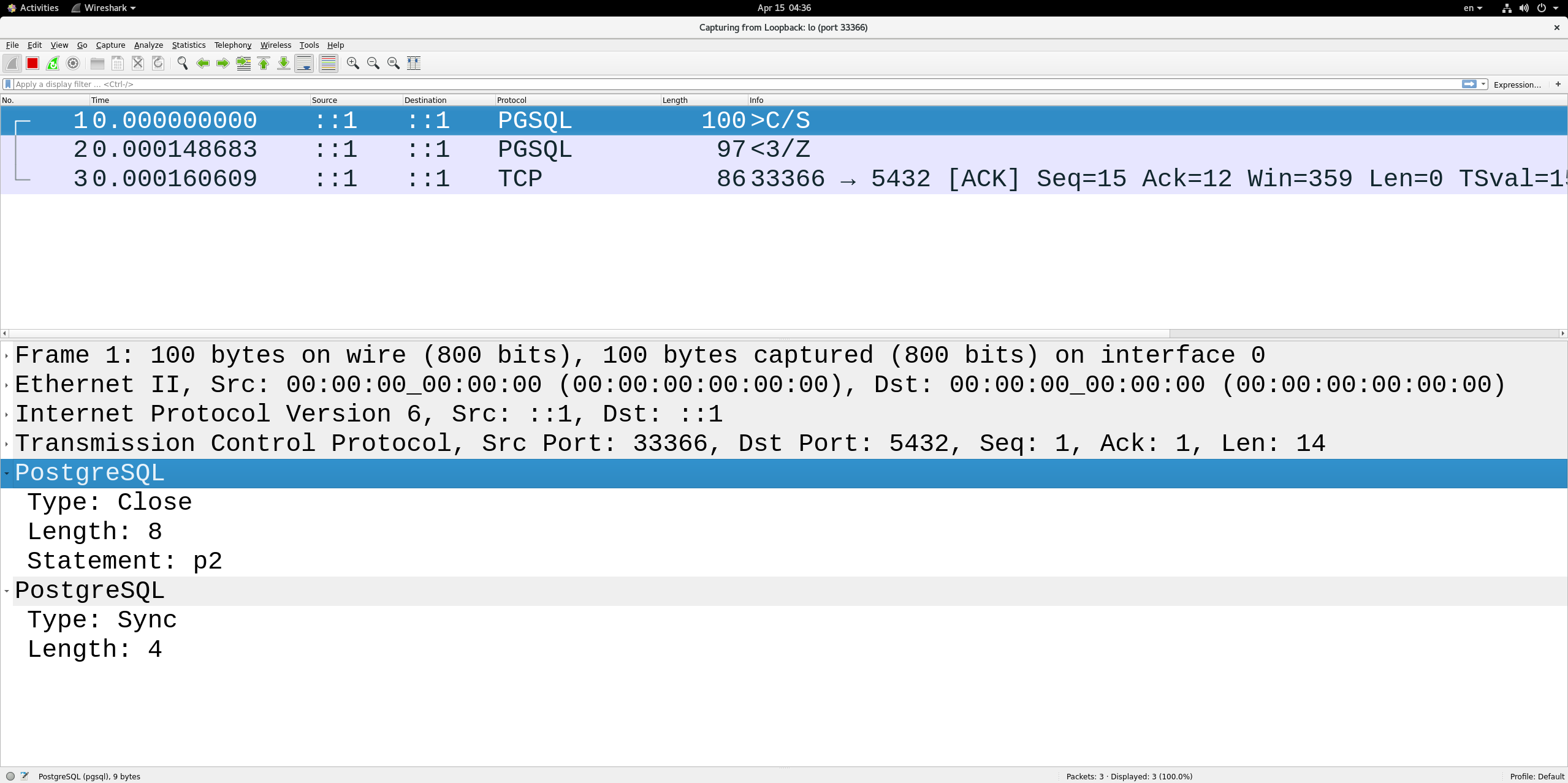

这里解释一下close消息的构造,如下:
/* construct the Close message */
if (pqPutMsgStart(command, conn) < 0 ||
pqPutc(type, conn) < 0 || // 1字节 S
pqPuts(target, conn) < 0 || // strlen("p2") + 1 = 3
pqPutMsgEnd(conn) < 0) // (conn->outMsgEnd - conn->outMsgStart)长度 4字节
goto sendFailed;
功能实现源码解析
辅助调试信息
上面是通过抓包工具得到的,接下来我们看一下PostgreSQL中提供的debug方式,如下:
#include <iostream>
#include "libpq-fe.h"
using namespace std;
int main()
{
const char *conninfo = "host=localhost port=5432 user=postgres dbname=postgres password=1";
const char *dropTableCmd = "drop table if exists t1;";
const char *createTableCmd = "create table t1(id int, name text);";
const char *insertCmd = "insert into t1 values(1, 'Oracle'), (2, 'MySQL'), (3, 'SQL Server');";
const char *prepareCmd0 = "table t1;";
const char *prepareCmd1 = "select * from t1 where id < $1;";
const char *prepareCmd2 = "select * from t1 where id = $1 and name = $2;";
PGresult *result = NULL;
ExecStatusType result_status;
int n_rows = 0, ntups = 0;
const char *values2[2] = {"2", "MySQL"};
FILE *file = fopen("/home/postgres/test/bin/1.txt", "w+");
PGconn *conn = PQconnectdb(conninfo);
PQtrace(conn, file);
if (PQstatus(conn) == CONNECTION_OK)
{
cout << "连接PostgreSQL数据库 成功!" << endl;
if (PQexec(conn, dropTableCmd) != NULL)
{
cout << "删除表成功" << endl;
}
if (PQexec(conn, createTableCmd) != NULL)
{
cout << "创建表成功" << endl;
}
if (PQexec(conn, insertCmd) != NULL)
{
cout << "插入表成功" << endl
<< endl;
}
/* ---------------------------------------------------------------- */
// prepare
if (PQsendPrepare(conn, "p23456789", prepareCmd2, 2, NULL) != NULL) // 异步
{
cout << "prepare p23456789 send成功" << endl;
}
while (NULL != (result = PQgetResult(conn)))
{
result_status = PQresultStatus(result);
if ((PGRES_EMPTY_QUERY != result_status) && (PGRES_COMMAND_OK != result_status) && (PGRES_TUPLES_OK != result_status) && (PGRES_NONFATAL_ERROR != result_status))
{
cout << "prepare p23456789 失败" << endl;
}
else
{
n_rows = atoi(PQcmdTuples(result));
ntups = PQntuples(result);
cout << "prepare p23456789 成功"
<< " n_rows: " << n_rows << " ntups: " << ntups << endl
<< endl;
}
PQclear(result);
}
/* ---------------------------------------------------------------- */
// exec_prepared
if (PQsendQueryPrepared(conn, "p23456789", 2, values2, NULL, NULL, 0) != NULL) // 异步
{
cout << "exec prepare p23456789 send成功" << endl;
}
while (NULL != (result = PQgetResult(conn)))
{
result_status = PQresultStatus(result);
if ((PGRES_EMPTY_QUERY != result_status) && (PGRES_COMMAND_OK != result_status) && (PGRES_TUPLES_OK != result_status) && (PGRES_NONFATAL_ERROR != result_status))
{
cout << "exec prepare p23456789 失败" << endl;
}
else
{
n_rows = atoi(PQcmdTuples(result));
ntups = PQntuples(result);
cout << "exec prepare p23456789 send成功"
<< " n_rows: " << n_rows << " ntups: " << ntups << endl
<< endl;
}
PQclear(result);
}
/* ---------------------------------------------------------------- */
// deallocate
result = PQexec(conn, "select pg_sleep(60);"); // 同步
PQclear(result);
if (PQsendClosePrepared(conn, "p23456789") != NULL) // 异步
{
cout << "close prepare p23456789 send成功" << endl;
}
while (NULL != (result = PQgetResult(conn)))
{
result_status = PQresultStatus(result);
if ((PGRES_EMPTY_QUERY != result_status) && (PGRES_COMMAND_OK != result_status) && (PGRES_TUPLES_OK != result_status) && (PGRES_NONFATAL_ERROR != result_status))
{
cout << "close prepare p23456789 失败" << endl;
}
else
{
n_rows = atoi(PQcmdTuples(result));
ntups = PQntuples(result);
cout << "close prepare p23456789 成功"
<< " n_rows: " << n_rows << " ntups: " << ntups << endl
<< endl;
}
PQclear(result);
}
/* ---------------------------------------------------------------- */
PQfinish(conn);
PQuntrace(conn);
cout << "与PostgreSQL数据库连接 关闭!" << endl;
}
else
{
cout << "连接失败!" << endl;
}
fclose(file);
return 0;
}
/*
* export LD_LIBRARY_PATH=$LD_LIBRARY_PATH:$PG_HOME/lib
*
* g++ libpqtest2.cpp -lpq -L/home/postgres/test/lib -I/home/postgres/test/include -o main -w -g -O0
*/
执行结果以及打印信息,如下:
[postgres@localhost:~/test/bin]$ ./main
连接PostgreSQL数据库 成功!
删除表成功
创建表成功
插入表成功
prepare p23456789 send成功
prepare p23456789 成功 n_rows: 0 ntups: 0
exec prepare p23456789 send成功
exec prepare p23456789 send成功 n_rows: 1 ntups: 1
close prepare p23456789 send成功
close prepare p23456789 成功 n_rows: 0 ntups: 0
与PostgreSQL数据库连接 关闭!
[postgres@localhost:~/test/bin]$ cat 1.txt
2024-04-16 20:22:43.371152 F 29 Query "drop table if exists t1;"
2024-04-16 20:22:43.381514 B 15 CommandComplete "DROP TABLE"
2024-04-16 20:22:43.381531 B 5 ReadyForQuery I
2024-04-16 20:22:43.381561 F 40 Query "create table t1(id int, name text);"
2024-04-16 20:22:43.388197 B 17 CommandComplete "CREATE TABLE"
2024-04-16 20:22:43.388215 B 5 ReadyForQuery I
2024-04-16 20:22:43.388239 F 73 Query "insert into t1 values(1, 'Oracle'), (2, 'MySQL'), (3, 'SQL Server');"
2024-04-16 20:22:43.388729 B 15 CommandComplete "INSERT 0 3"
2024-04-16 20:22:43.388736 B 5 ReadyForQuery I
2024-04-16 20:22:43.388758 F 62 Parse "p23456789" "select * from t1 where id = $1 and name = $2;" 0
2024-04-16 20:22:43.388762 F 4 Sync
2024-04-16 20:22:43.390728 B 4 ParseComplete
2024-04-16 20:22:43.390767 B 5 ReadyForQuery I
2024-04-16 20:22:43.390772 F 37 Bind "" "p23456789" 0 2 1 '2' 5 'MySQL' 1 0
2024-04-16 20:22:43.390775 F 6 Describe P ""
2024-04-16 20:22:43.390777 F 9 Execute "" 0
2024-04-16 20:22:43.390779 F 4 Sync
2024-04-16 20:22:43.392433 B 4 BindComplete
2024-04-16 20:22:43.392483 B 50 RowDescription 2 "id" 16403 1 23 4 -1 0 "name" 16403 2 25 65535 -1 0
2024-04-16 20:22:43.392494 B 20 DataRow 2 1 '2' 5 'MySQL'
2024-04-16 20:22:43.392500 B 13 CommandComplete "SELECT 1"
2024-04-16 20:22:43.392644 B 5 ReadyForQuery I
2024-04-16 20:22:43.392725 F 25 Query "select pg_sleep(60);"
2024-04-16 20:23:43.406609 B 33 RowDescription 1 "pg_sleep" 0 0 2278 4 -1 0
2024-04-16 20:23:43.406637 B 10 DataRow 1 0 ''
2024-04-16 20:23:43.406642 B 13 CommandComplete "SELECT 1"
2024-04-16 20:23:43.406645 B 5 ReadyForQuery I
2024-04-16 20:23:43.406654 F 15 Close S "p23456789"
2024-04-16 20:23:43.406657 F 4 Sync
2024-04-16 20:23:43.406885 B 4 CloseComplete
2024-04-16 20:23:43.406928 B 5 ReadyForQuery I
2024-04-16 20:23:43.406938 F 4 Terminate
[postgres@localhost:~/test/bin]$
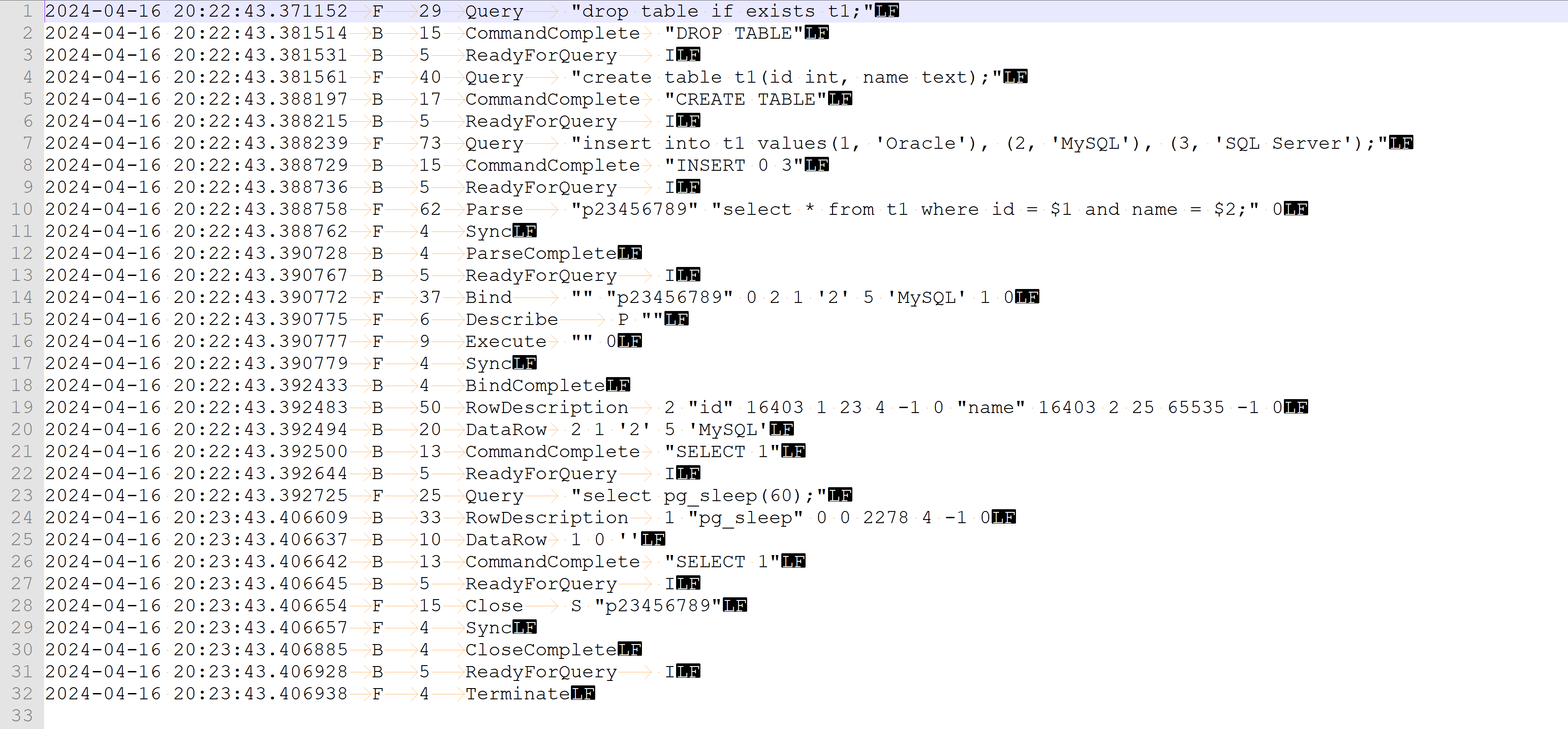
如上是通过直接调用libpq中的函数PQtrace和PQuntrace,如下:
// src/interfaces/libpq/fe-trace.c
/* Enable tracing */
void
PQtrace(PGconn *conn, FILE *debug_port)
{
if (conn == NULL)
return;
PQuntrace(conn);
if (debug_port == NULL)
return;
conn->Pfdebug = debug_port;
conn->traceFlags = 0;
}
/* Disable tracing */
void
PQuntrace(PGconn *conn)
{
if (conn == NULL)
return;
if (conn->Pfdebug)
{
fflush(conn->Pfdebug);
conn->Pfdebug = NULL;
}
conn->traceFlags = 0;
}
当然如上两函数是trace的开关函数,真正实现打印的逻辑 如下:
// src/interfaces/libpq/fe-trace.c
/*
* Print the given message to the trace output stream.
* 将给定消息打印到跟踪输出流
*/
void
pqTraceOutputMessage(PGconn *conn, const char *message, bool toServer)
{
char id;
int length;
char *prefix = toServer ? "F" : "B"; // 这里指的是 Front / Backend
int logCursor = 0;
bool regress;
if ((conn->traceFlags & PQTRACE_SUPPRESS_TIMESTAMPS) == 0)
{
char timestr[128];
pqTraceFormatTimestamp(timestr, sizeof(timestr));
fprintf(conn->Pfdebug, "%s\t", timestr);
}
regress = (conn->traceFlags & PQTRACE_REGRESS_MODE) != 0;
id = message[logCursor++];
memcpy(&length, message + logCursor, 4);
length = (int) pg_ntoh32(length);
logCursor += 4;
/*
* In regress mode, suppress the length of ErrorResponse and
* NoticeResponse. The F (file name), L (line number) and R (routine
* name) fields can change as server code is modified, and if their
* lengths differ from the originals, that would break tests.
*
* 在回归模式下,抑制ErrorResponse和NoticeResponse的长度
* F(文件名)、L(行号)和 R(例程名称)字段可能会随着服务器代码的修改而更改
* 如果它们的长度与原始长度不同,则会破坏测试
*/
if (regress && !toServer && (id == 'E' || id == 'N'))
fprintf(conn->Pfdebug, "%s\tNN\t", prefix);
else
fprintf(conn->Pfdebug, "%s\t%d\t", prefix, length);
switch (id)
{
case PqMsg_ParseComplete:
fprintf(conn->Pfdebug, "ParseComplete");
/* No message content */
break;
case PqMsg_BindComplete:
fprintf(conn->Pfdebug, "BindComplete");
/* No message content */
break;
case PqMsg_CloseComplete:
fprintf(conn->Pfdebug, "CloseComplete");
/* No message content */
break;
case PqMsg_NotificationResponse:
pqTraceOutputA(conn->Pfdebug, message, &logCursor, regress);
break;
case PqMsg_Bind:
pqTraceOutputB(conn->Pfdebug, message, &logCursor);
break;
case PqMsg_CopyDone:
fprintf(conn->Pfdebug, "CopyDone");
/* No message content */
break;
case PqMsg_CommandComplete:
/* Close(F) and CommandComplete(B) use the same identifier. */
Assert(PqMsg_Close == PqMsg_CommandComplete);
pqTraceOutputC(conn->Pfdebug, toServer, message, &logCursor);
break;
case PqMsg_CopyData:
/* Drop COPY data to reduce the overhead of logging. */
break;
case PqMsg_Describe:
/* Describe(F) and DataRow(B) use the same identifier. */
Assert(PqMsg_Describe == PqMsg_DataRow);
pqTraceOutputD(conn->Pfdebug, toServer, message, &logCursor);
break;
case PqMsg_Execute:
/* Execute(F) and ErrorResponse(B) use the same identifier. */
Assert(PqMsg_Execute == PqMsg_ErrorResponse);
pqTraceOutputE(conn->Pfdebug, toServer, message, &logCursor,
regress);
break;
case PqMsg_CopyFail:
pqTraceOutputf(conn->Pfdebug, message, &logCursor);
break;
case PqMsg_FunctionCall:
pqTraceOutputF(conn->Pfdebug, message, &logCursor, regress);
break;
case PqMsg_CopyInResponse:
pqTraceOutputG(conn->Pfdebug, message, &logCursor);
break;
case PqMsg_Flush:
/* Flush(F) and CopyOutResponse(B) use the same identifier */
Assert(PqMsg_CopyOutResponse == PqMsg_Flush);
if (!toServer)
pqTraceOutputH(conn->Pfdebug, message, &logCursor);
else
fprintf(conn->Pfdebug, "Flush"); /* no message content */
break;
case PqMsg_EmptyQueryResponse:
fprintf(conn->Pfdebug, "EmptyQueryResponse");
/* No message content */
break;
case PqMsg_BackendKeyData:
pqTraceOutputK(conn->Pfdebug, message, &logCursor, regress);
break;
case PqMsg_NoData:
fprintf(conn->Pfdebug, "NoData");
/* No message content */
break;
case PqMsg_NoticeResponse:
pqTraceOutputNR(conn->Pfdebug, "NoticeResponse", message,
&logCursor, regress);
break;
case PqMsg_Parse:
pqTraceOutputP(conn->Pfdebug, message, &logCursor, regress);
break;
case PqMsg_Query:
pqTraceOutputQ(conn->Pfdebug, message, &logCursor);
break;
case PqMsg_AuthenticationRequest:
pqTraceOutputR(conn->Pfdebug, message, &logCursor);
break;
case PqMsg_PortalSuspended:
fprintf(conn->Pfdebug, "PortalSuspended");
/* No message content */
break;
case PqMsg_Sync:
/* Parameter Status(B) and Sync(F) use the same identifier */
Assert(PqMsg_ParameterStatus == PqMsg_Sync);
if (!toServer)
pqTraceOutputS(conn->Pfdebug, message, &logCursor);
else
fprintf(conn->Pfdebug, "Sync"); /* no message content */
break;
case PqMsg_ParameterDescription:
pqTraceOutputt(conn->Pfdebug, message, &logCursor, regress);
break;
case PqMsg_RowDescription:
pqTraceOutputT(conn->Pfdebug, message, &logCursor, regress);
break;
case PqMsg_NegotiateProtocolVersion:
pqTraceOutputv(conn->Pfdebug, message, &logCursor);
break;
case PqMsg_FunctionCallResponse:
pqTraceOutputV(conn->Pfdebug, message, &logCursor);
break;
case PqMsg_CopyBothResponse:
pqTraceOutputW(conn->Pfdebug, message, &logCursor, length);
break;
case PqMsg_Terminate:
fprintf(conn->Pfdebug, "Terminate");
/* No message content */
break;
case PqMsg_ReadyForQuery:
pqTraceOutputZ(conn->Pfdebug, message, &logCursor);
break;
default:
fprintf(conn->Pfdebug, "Unknown message: %02x", id);
break;
}
fputc('\n', conn->Pfdebug);
/*
* Verify the printing routine did it right. Note that the one-byte
* message identifier is not included in the length, but our cursor does
* include it.
*
* 验证打印例程是否正确
* 请注意,一字节消息标识符不包括在长度中,但我们的光标确实包括它
*/
if (logCursor - 1 != length)
fprintf(conn->Pfdebug,
"mismatched message length: consumed %d, expected %d\n",
logCursor - 1, length);
}
接下来我们重点看一下close消息的打印,如下:
pqTraceOutputMessage
|
pqTraceOutputC
/* Close(F) or CommandComplete(B) */
static void
pqTraceOutputC(FILE *f, bool toServer, const char *message, int *cursor)
{
if (toServer)
{
fprintf(f, "Close\t");
pqTraceOutputByte1(f, message, cursor);
pqTraceOutputString(f, message, cursor, false);
}
else
{
fprintf(f, "CommandComplete\t");
pqTraceOutputString(f, message, cursor, false);
}
}
/*
* pqTraceOutputByte1: output a 1-char message to the log
* pqTraceOutputByte1:将 1 个字符的消息输出到日志
*/
static void
pqTraceOutputByte1(FILE *pfdebug, const char *data, int *cursor)
{
const char *v = data + *cursor;
/*
* Show non-printable data in hex format, including the terminating \0
* that completes ErrorResponse and NoticeResponse messages.
*
* 以十六进制格式显示不可打印的数据
* 包括完成ErrorResponse 和NoticeResponse 消息的终止\0
*/
if (!isprint((unsigned char) *v))
fprintf(pfdebug, " \\x%02x", *v);
else
fprintf(pfdebug, " %c", *v);
*cursor += 1;
}
/*
* pqTraceOutputString: output a string message to the log
* pqTraceOutputString:输出字符串消息到日志
*/
static void
pqTraceOutputString(FILE *pfdebug, const char *data, int *cursor, bool suppress)
{
int len;
if (suppress)
{
fprintf(pfdebug, " \"SSSS\"");
*cursor += strlen(data + *cursor) + 1;
}
else
{
len = fprintf(pfdebug, " \"%s\"", data + *cursor);
/*
* This is a null-terminated string. So add 1 after subtracting 3
* which is the double quotes and space length from len.
*
* 这是一个以 null 结尾的字符串
* 因此,从 len 中减去双引号和空格长度 3 后加 1
*/
*cursor += (len - 3 + 1);
}
}
接下来我们继续以close消息为例,详细看一下message的构造和解析过程!
## len = 15
2024-04-16 20:23:43.406654 F 15 Close S "p23456789"
前端信息构造
此时的函数堆栈,如下:
libpq.so.5!PQsendTypedCommand(PGconn * conn, char command, char type, const char * target) (\home\postgres\postgres\src\interfaces\libpq\fe-exec.c:2605)
libpq.so.5!PQsendClosePrepared(PGconn * conn, const char * stmt) (\home\postgres\postgres\src\interfaces\libpq\fe-exec.c:2558)
main() (\home\postgres\test\bin\libpqtest2.cpp:110)
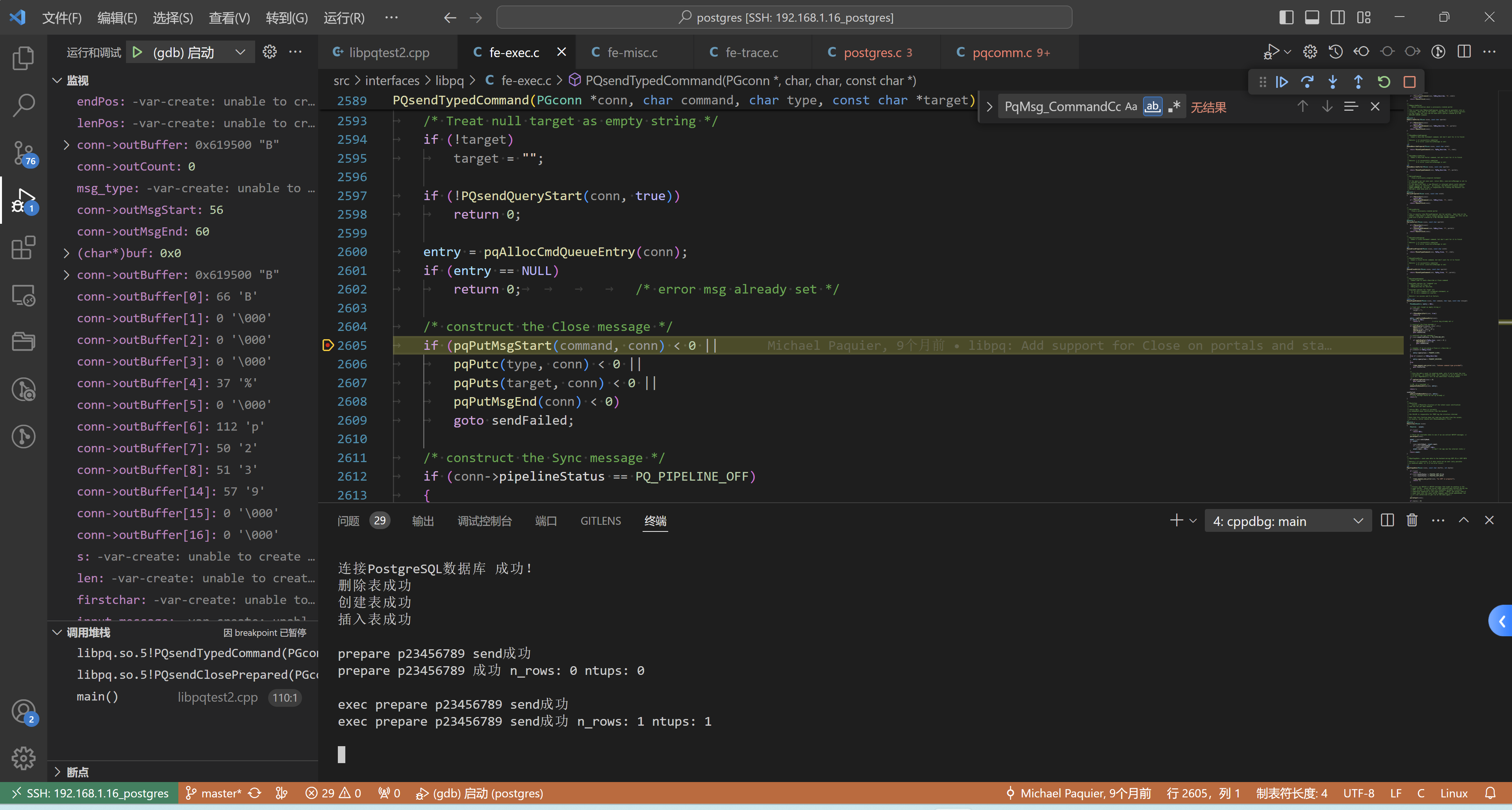
接下来就详细看一下这里的处理逻辑,如下:
第一步:
// src/interfaces/libpq/fe-exec.c
/*
* pqPutMsgStart: begin construction of a message to the server
* pqPutMsgStart:开始向服务器构造消息
*
* msg_type is the message type byte, or 0 for a message without type byte
* (only startup messages have no type byte)
* msg_type 是消息类型字节,如果没有类型字节,则为 0(只有启动消息没有类型字节)
*
* Returns 0 on success, EOF on error
* 成功时返回 0,错误时返回 EOF
*
* The idea here is that we construct the message in conn->outBuffer,
* beginning just past any data already in outBuffer (ie, at
* outBuffer+outCount). We enlarge the buffer as needed to hold the message.
* When the message is complete, we fill in the length word (if needed) and
* then advance outCount past the message, making it eligible to send.
* 这里的想法是,我们在 conn->outBuffer 中构造消息,从 outBuffer 中已有的任何数据开始(即,在 outBuffer+outCount 处)
* 我们根据需要扩大缓冲区来保存消息
* 消息完成后,我们填写长度字(如果需要),然后将 outCount 提前到消息后面,使其符合发送条件
*
* The state variable conn->outMsgStart points to the incomplete message's
* length word: it is either outCount or outCount+1 depending on whether
* there is a type byte. The state variable conn->outMsgEnd is the end of
* the data collected so far.
* 状态变量 conn->outMsgStart 指向不完整消息的长度字:
* 它是 outCount 或 outCount+1,具体取决于是否存在类型字节
* 状态变量 conn->outMsgEnd 是迄今为止收集的数据的结尾
*/
int
pqPutMsgStart(char msg_type, PGconn *conn)
{
int lenPos;
int endPos;
/* allow room for message type byte */
if (msg_type)
endPos = conn->outCount + 1;
else
endPos = conn->outCount;
/* do we want a length word? */
lenPos = endPos;
/* allow room for message length */
endPos += 4;
/* make sure there is room for message header */
if (pqCheckOutBufferSpace(endPos, conn))
return EOF;
/* okay, save the message type byte if any */
if (msg_type)
conn->outBuffer[conn->outCount] = msg_type;
/* set up the message pointers */
conn->outMsgStart = lenPos;
conn->outMsgEnd = endPos;
/* length word, if needed, will be filled in by pqPutMsgEnd */
return 0;
}
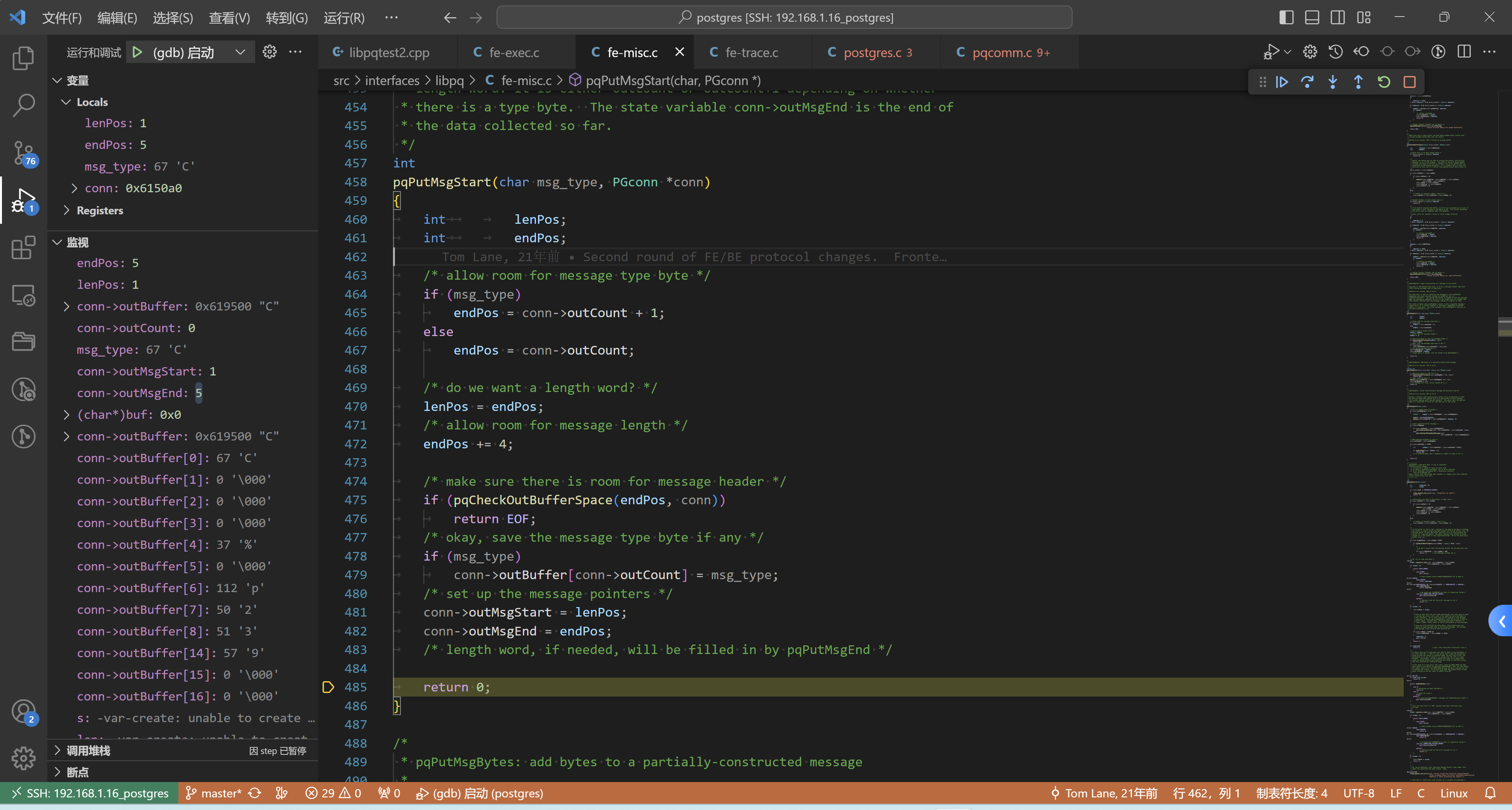
解释一下:
- msg_type此时是
C endPos += 4;就代表了 已经把消息长度的空间分配好了- conn->outCount = 0
- conn->outBuffer[conn->outCount] = msg_type; // 放的就是 C
- conn->outMsgStart = 1
- conn->outMsgEnd = 5
第二步:
libpq.so.5!pqPutMsgBytes(const void * buf, size_t len, PGconn * conn) (\home\postgres\postgres\src\interfaces\libpq\fe-misc.c:497)
libpq.so.5!pqPutc(char c, PGconn * conn) (\home\postgres\postgres\src\interfaces\libpq\fe-misc.c:94)
libpq.so.5!PQsendTypedCommand(PGconn * conn, char command, char type, const char * target) (\home\postgres\postgres\src\interfaces\libpq\fe-exec.c:2606)
libpq.so.5!PQsendClosePrepared(PGconn * conn, const char * stmt) (\home\postgres\postgres\src\interfaces\libpq\fe-exec.c:2558)
main() (\home\postgres\test\bin\libpqtest2.cpp:110)
/*
* pqPutc: write 1 char to the current message
*/
int
pqPutc(char c, PGconn *conn)
{
if (pqPutMsgBytes(&c, 1, conn))
return EOF;
return 0;
}
...
/*
* pqPutMsgBytes: add bytes to a partially-constructed message
* pqPutMsgBytes:向部分构造的消息添加字节
*
* Returns 0 on success, EOF on error
*/
static int
pqPutMsgBytes(const void *buf, size_t len, PGconn *conn)
{
/* make sure there is room for it */
if (pqCheckOutBufferSpace(conn->outMsgEnd + len, conn))
return EOF;
/* okay, save the data */
memcpy(conn->outBuffer + conn->outMsgEnd, buf, len);
conn->outMsgEnd += len;
/* no Pfdebug call here, caller should do it */
return 0;
}

解释一下:
- 因为 type 是’S’,因此这里写的就是它
- 因为内存copy是从
conn->outBuffer + conn->outMsgEnd开始的,也就放到了conn->outBuffer[5] - conn->outMsgEnd += 1
第三步:
libpq.so.5!pqPutMsgBytes(const void * buf, size_t len, PGconn * conn) (\home\postgres\postgres\src\interfaces\libpq\fe-misc.c:500)
libpq.so.5!pqPuts(const char * s, PGconn * conn) (\home\postgres\postgres\src\interfaces\libpq\fe-misc.c:154)
libpq.so.5!PQsendTypedCommand(PGconn * conn, char command, char type, const char * target) (\home\postgres\postgres\src\interfaces\libpq\fe-exec.c:2607)
libpq.so.5!PQsendClosePrepared(PGconn * conn, const char * stmt) (\home\postgres\postgres\src\interfaces\libpq\fe-exec.c:2558)
main() (\home\postgres\test\bin\libpqtest2.cpp:110)
/*
* pqPuts: write a null-terminated string to the current message
* pqPuts:将空终止字符串写入当前消息
*/
int
pqPuts(const char *s, PGconn *conn)
{
if (pqPutMsgBytes(s, strlen(s) + 1, conn))
return EOF;
return 0;
}
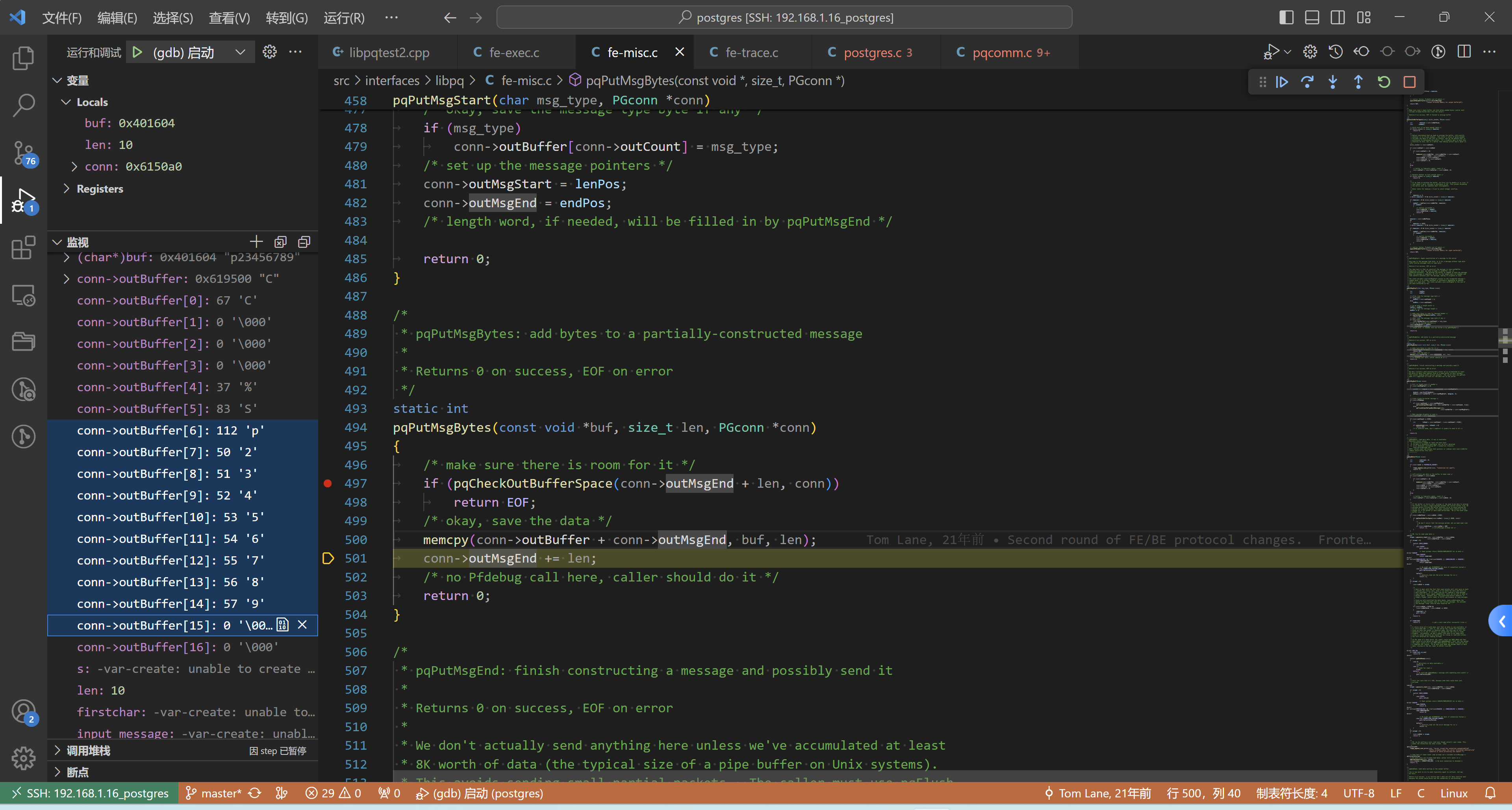
解释一下:
- len = strlen + 1; strlen(“p23456789”) + 1 = 10
- 内存copy是从
conn->outMsgEnd = 6开始的,len = 10。自然结果如上 - conn->outMsgEnd += 10
第四步:
libpq.so.5!pqPutMsgEnd(PGconn * conn) (\home\postgres\postgres\src\interfaces\libpq\fe-misc.c:520)
libpq.so.5!PQsendTypedCommand(PGconn * conn, char command, char type, const char * target) (\home\postgres\postgres\src\interfaces\libpq\fe-exec.c:2608)
libpq.so.5!PQsendClosePrepared(PGconn * conn, const char * stmt) (\home\postgres\postgres\src\interfaces\libpq\fe-exec.c:2558)
main() (\home\postgres\test\bin\libpqtest2.cpp:110)
/*
* pqPutMsgEnd: finish constructing a message and possibly send it
* pqPutMsgEnd:完成构建消息并可能发送它
*
* Returns 0 on success, EOF on error
*
* We don't actually send anything here unless we've accumulated at least
* 8K worth of data (the typical size of a pipe buffer on Unix systems).
* This avoids sending small partial packets. The caller must use pqFlush
* when it's important to flush all the data out to the server.
*
* 除非我们已经积累了至少 8K 的数据(Unix 系统上管道缓冲区的典型大小),否则我们实际上不会在这里发送任何内容
* 这避免了发送小部分数据包
* 当需要将所有数据刷新到服务器时,调用者必须使用 pqFlush
*/
int
pqPutMsgEnd(PGconn *conn)
{
/* Fill in length word if needed */
if (conn->outMsgStart >= 0)
{
uint32 msgLen = conn->outMsgEnd - conn->outMsgStart;
msgLen = pg_hton32(msgLen);
memcpy(conn->outBuffer + conn->outMsgStart, &msgLen, 4);
}
/* trace client-to-server message */
if (conn->Pfdebug)
{
if (conn->outCount < conn->outMsgStart)
pqTraceOutputMessage(conn, conn->outBuffer + conn->outCount, true);
else
pqTraceOutputNoTypeByteMessage(conn,
conn->outBuffer + conn->outMsgStart);
}
/* Make message eligible to send */
conn->outCount = conn->outMsgEnd;
if (conn->outCount >= 8192)
{
int toSend = conn->outCount - (conn->outCount % 8192);
if (pqSendSome(conn, toSend) < 0)
return EOF;
/* in nonblock mode, don't complain if unable to send it all */
}
return 0;
}
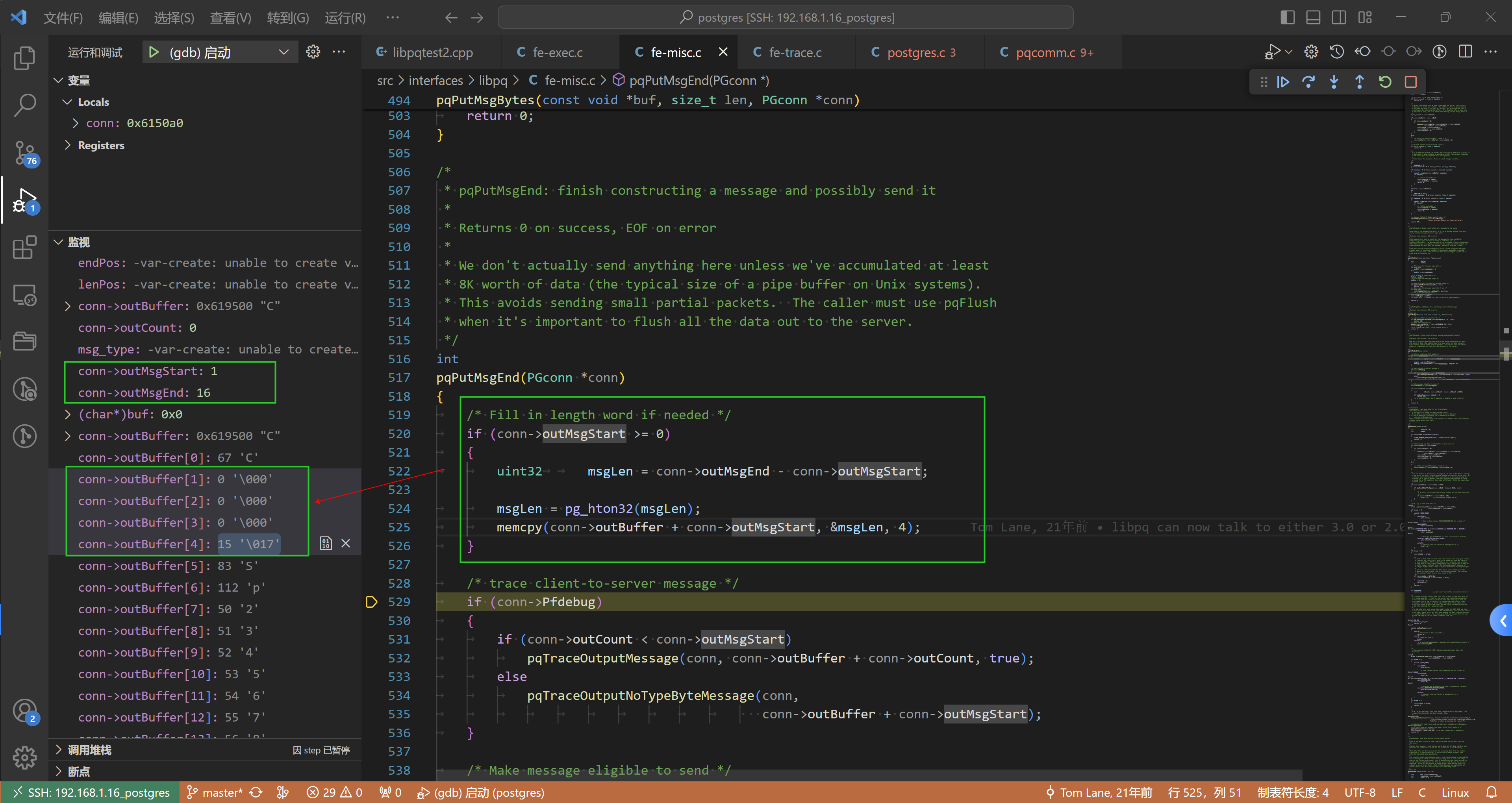
解释一下:
- 如上 message_len = 16 - 1 = 15,然后大端存储
- 内存copy是从
conn->outMsgStart = 1开始,长度是4 自然就是上面的四字节 - conn->outCount = conn->outMsgEnd = 16
至此,该15字节的close消息构建完毕!
后端消息解析
我们这里调试服务进程,如下:
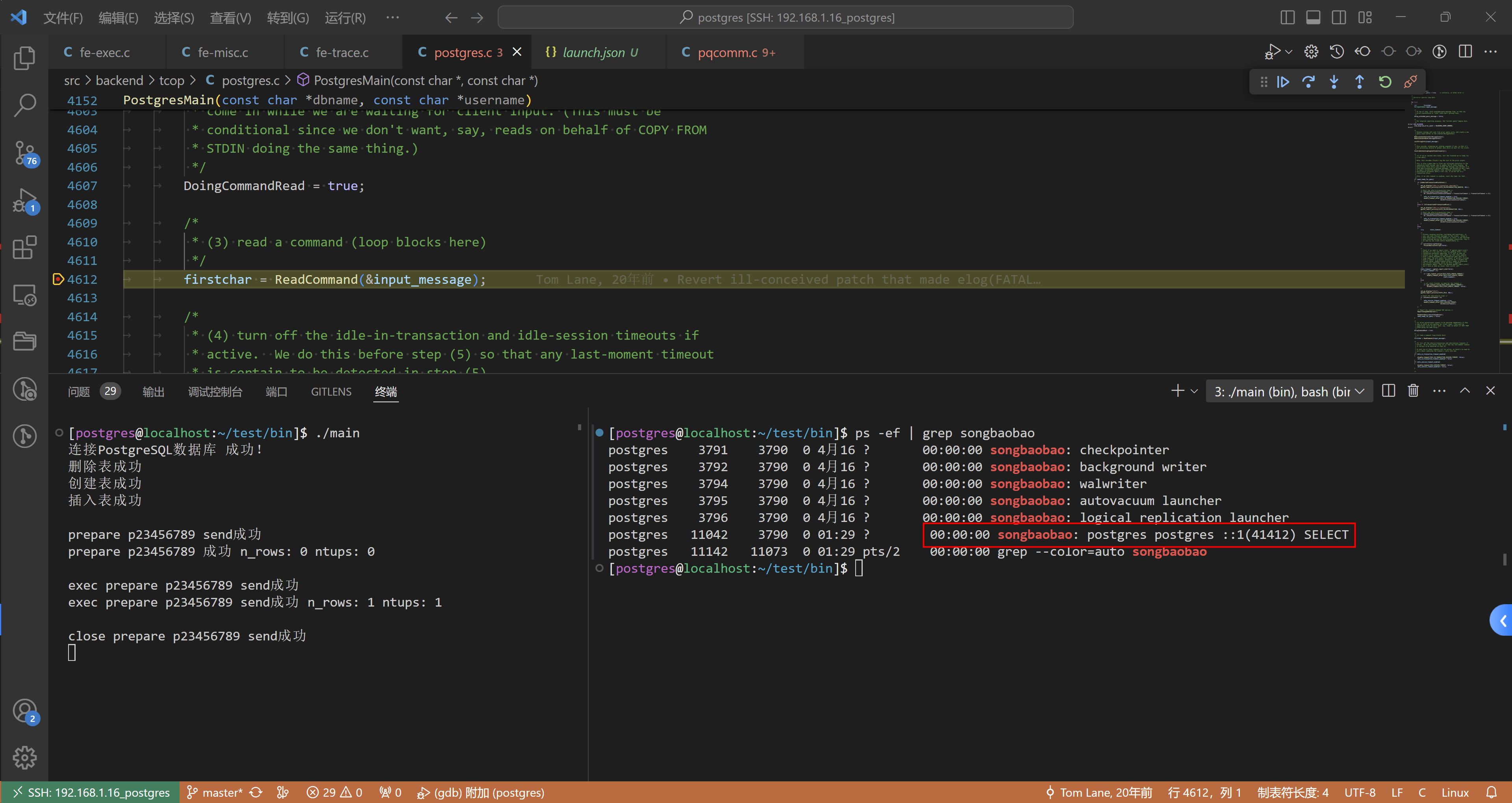
第一步:消息读取,如下:
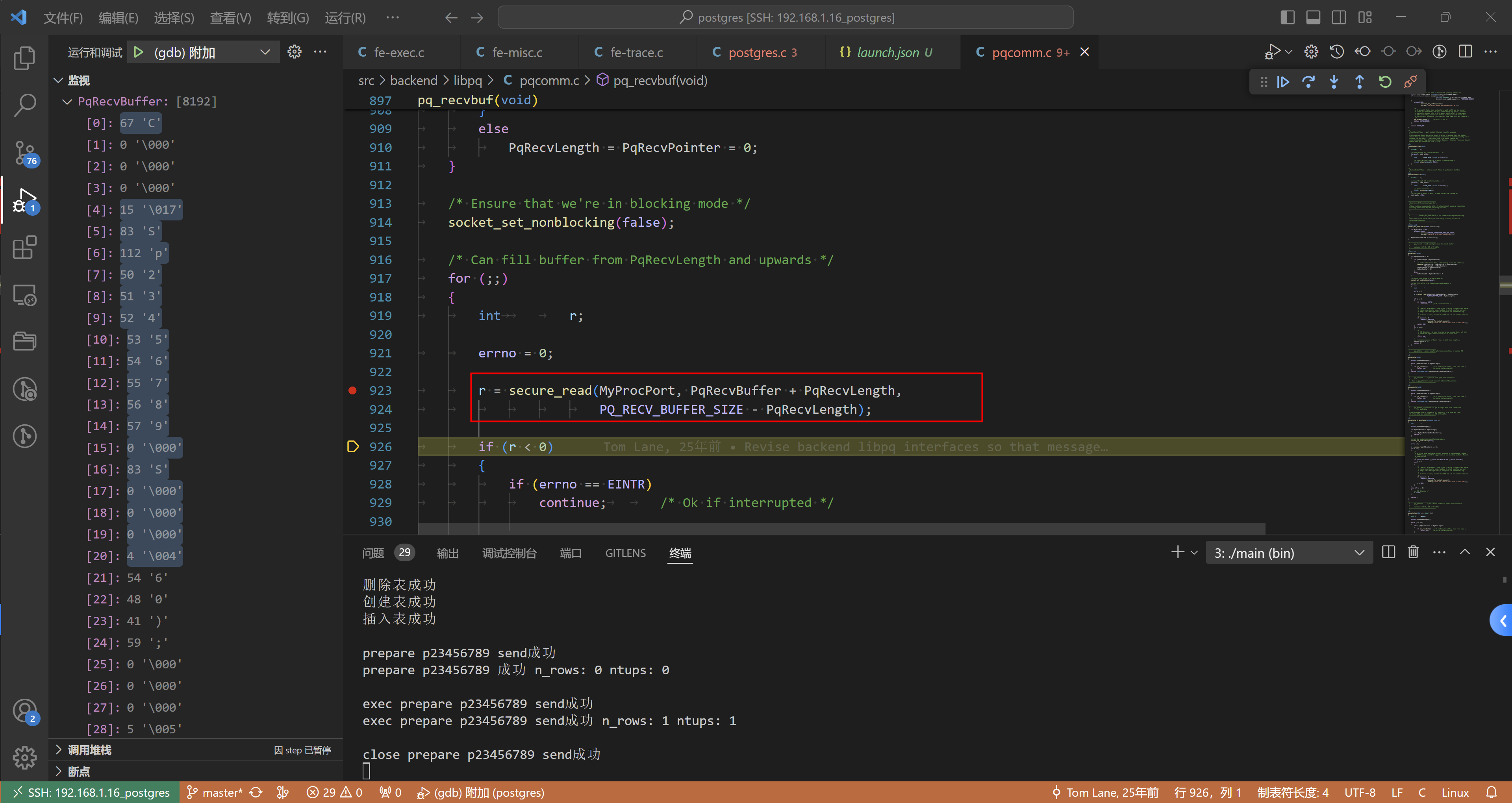
pq_recvbuf() (\home\postgres\postgres\src\backend\libpq\pqcomm.c:926)
pq_getbyte() (\home\postgres\postgres\src\backend\libpq\pqcomm.c:969)
SocketBackend(StringInfo inBuf) (\home\postgres\postgres\src\backend\tcop\postgres.c:370)
ReadCommand(StringInfo inBuf) (\home\postgres\postgres\src\backend\tcop\postgres.c:493)
PostgresMain(const char * dbname, const char * username) (\home\postgres\postgres\src\backend\tcop\postgres.c:4612)
BackendMain(char * startup_data, size_t startup_data_len) (\home\postgres\postgres\src\backend\tcop\backend_startup.c:105)
postmaster_child_launch(BackendType child_type, char * startup_data, size_t startup_data_len, ClientSocket * client_sock) (\home\postgres\postgres\src\backend\postmaster\launch_backend.c:265)
BackendStartup(ClientSocket * client_sock) (\home\postgres\postgres\src\backend\postmaster\postmaster.c:3593)
ServerLoop() (\home\postgres\postgres\src\backend\postmaster\postmaster.c:1674)
PostmasterMain(int argc, char ** argv) (\home\postgres\postgres\src\backend\postmaster\postmaster.c:1372)
main(int argc, char ** argv) (\home\postgres\postgres\src\backend\main\main.c:197)
// src/backend/libpq/pqcomm.c
/* --------------------------------
* pq_recvbuf - load some bytes into the input buffer
* pq_recvbuf - 将一些字节加载到输入缓冲区中
*
* returns 0 if OK, EOF if trouble
* --------------------------------
*/
static int
pq_recvbuf(void)
{
if (PqRecvPointer > 0)
{
if (PqRecvLength > PqRecvPointer)
{
/* still some unread data, left-justify it in the buffer */
// 还有一些未读数据,将其在缓冲区中左对齐
memmove(PqRecvBuffer, PqRecvBuffer + PqRecvPointer,
PqRecvLength - PqRecvPointer);
PqRecvLength -= PqRecvPointer;
PqRecvPointer = 0;
}
else
PqRecvLength = PqRecvPointer = 0;
}
/* Ensure that we're in blocking mode */
// 确保我们处于阻塞模式
socket_set_nonblocking(false);
/* Can fill buffer from PqRecvLength and upwards */
// 可以从 PqRecvLength 及以上填充缓冲区
for (;;)
{
int r;
errno = 0;
r = secure_read(MyProcPort, PqRecvBuffer + PqRecvLength,
PQ_RECV_BUFFER_SIZE - PqRecvLength);
if (r < 0)
{
if (errno == EINTR)
continue; /* Ok if interrupted */
/*
* Careful: an ereport() that tries to write to the client would
* cause recursion to here, leading to stack overflow and core
* dump! This message must go *only* to the postmaster log.
* 小心:尝试写入客户端的 ereport() 会导致递归到此处,从而导致堆栈溢出和核心转储
* 此消息必须 *仅* 发送到邮件管理员日志
*
* If errno is zero, assume it's EOF and let the caller complain.
* 如果 errno 为零,则假设它是 EOF 并让调用者抱怨
*/
if (errno != 0)
ereport(COMMERROR,
(errcode_for_socket_access(),
errmsg("could not receive data from client: %m")));
return EOF;
}
if (r == 0)
{
/*
* EOF detected. We used to write a log message here, but it's
* better to expect the ultimate caller to do that.
* 检测到 EOF
* 我们曾经在这里编写日志消息,但最好期望最终调用者这样做
*/
return EOF;
}
/* r contains number of bytes read, so just incr length */
// r 包含读取的字节数,因此只需增加长度
PqRecvLength += r;
return 0;
}
}
解释一下:
- PqRecvLength = 21 这个其实是两条消息 如下:
/* construct the Close message */ // 0 - 15
if (pqPutMsgStart(command, conn) < 0 ||
pqPutc(type, conn) < 0 ||
pqPuts(target, conn) < 0 ||
pqPutMsgEnd(conn) < 0)
goto sendFailed;
/* construct the Sync message */ // 16 - 20
if (conn->pipelineStatus == PQ_PIPELINE_OFF)
{
if (pqPutMsgStart(PqMsg_Sync, conn) < 0 ||
pqPutMsgEnd(conn) < 0)
goto sendFailed;
}
第二步:
/* --------------------------------
* pq_getbyte - get a single byte from connection, or return EOF
* --------------------------------
*/
int
pq_getbyte(void)
{
Assert(PqCommReadingMsg);
while (PqRecvPointer >= PqRecvLength)
{
if (pq_recvbuf()) /* If nothing in buffer, then recv some */
return EOF; /* Failed to recv data */
}
return (unsigned char) PqRecvBuffer[PqRecvPointer++];
}
解释一下:
- 此时 PqRecvPointer = 0,自然返回的是
'C'
第三步:
...
/*
* In protocol version 3, all frontend messages have a length word next
* after the type code; we can read the message contents independently of
* the type.
*
* 在协议版本 3 中,所有前端消息在类型代码之后都有一个长度字
* 我们可以独立于类型来读取消息内容
*/
if (pq_getmessage(inBuf, maxmsglen))
return EOF; /* suitable message already logged */
RESUME_CANCEL_INTERRUPTS();
...
/* --------------------------------
* pq_getmessage - get a message with length word from connection
* pq_getmessage - 从连接获取长度字的消息
*
* The return value is placed in an expansible StringInfo, which has
* already been initialized by the caller.
* Only the message body is placed in the StringInfo; the length word
* is removed. Also, s->cursor is initialized to zero for convenience
* in scanning the message contents.
* 返回值放置在可扩展的 StringInfo 中,该 StringInfo 已由调用者初始化
* StringInfo中只放置消息体; 长度词被删除
* 另外,为了方便扫描消息内容,s->cursor 被初始化为零
*
* maxlen is the upper limit on the length of the
* message we are willing to accept. We abort the connection (by
* returning EOF) if client tries to send more than that.
* maxlen 是我们愿意接受的消息长度的上限
* 如果客户端尝试发送更多内容,我们将中止连接(通过返回 EOF)
*
* returns 0 if OK, EOF if trouble
* --------------------------------
*/
int
pq_getmessage(StringInfo s, int maxlen)
{
int32 len;
Assert(PqCommReadingMsg);
resetStringInfo(s);
/* Read message length word */
if (pq_getbytes((char *) &len, 4) == EOF)
{
ereport(COMMERROR,
(errcode(ERRCODE_PROTOCOL_VIOLATION),
errmsg("unexpected EOF within message length word")));
return EOF;
}
len = pg_ntoh32(len);
if (len < 4 || len > maxlen)
{
ereport(COMMERROR,
(errcode(ERRCODE_PROTOCOL_VIOLATION),
errmsg("invalid message length")));
return EOF;
}
len -= 4; /* discount length itself */
if (len > 0)
{
/*
* Allocate space for message. If we run out of room (ridiculously
* large message), we will elog(ERROR), but we want to discard the
* message body so as not to lose communication sync.
*/
PG_TRY();
{
enlargeStringInfo(s, len);
}
PG_CATCH();
{
if (pq_discardbytes(len) == EOF)
ereport(COMMERROR,
(errcode(ERRCODE_PROTOCOL_VIOLATION),
errmsg("incomplete message from client")));
/* we discarded the rest of the message so we're back in sync. */
PqCommReadingMsg = false;
PG_RE_THROW();
}
PG_END_TRY();
/* And grab the message */
if (pq_getbytes(s->data, len) == EOF)
{
ereport(COMMERROR,
(errcode(ERRCODE_PROTOCOL_VIOLATION),
errmsg("incomplete message from client")));
return EOF;
}
s->len = len;
/* Place a trailing null per StringInfo convention */
s->data[len] = '\0';
}
/* finished reading the message. */
PqCommReadingMsg = false;
return 0;
}
解释一下:
- 读取长度 4字节:
memcpy(s, PqRecvBuffer + PqRecvPointer, amount);此时 PqRecvPointer = 1 - pg_ntoh32 网络序–>主机序 len = 15
len -= 4; /* discount length itself */- 读取长度 11 字节:
memcpy(s, PqRecvBuffer + PqRecvPointer, amount);此时 PqRecvPointer = 5 - 此时读取的内容:
0x1e54c88 "Sp23456789",也就是input_message
接下来ReadCommand的结果,如下:
firstchar = ReadCommand(&input_message); // C
最后一步,如下:
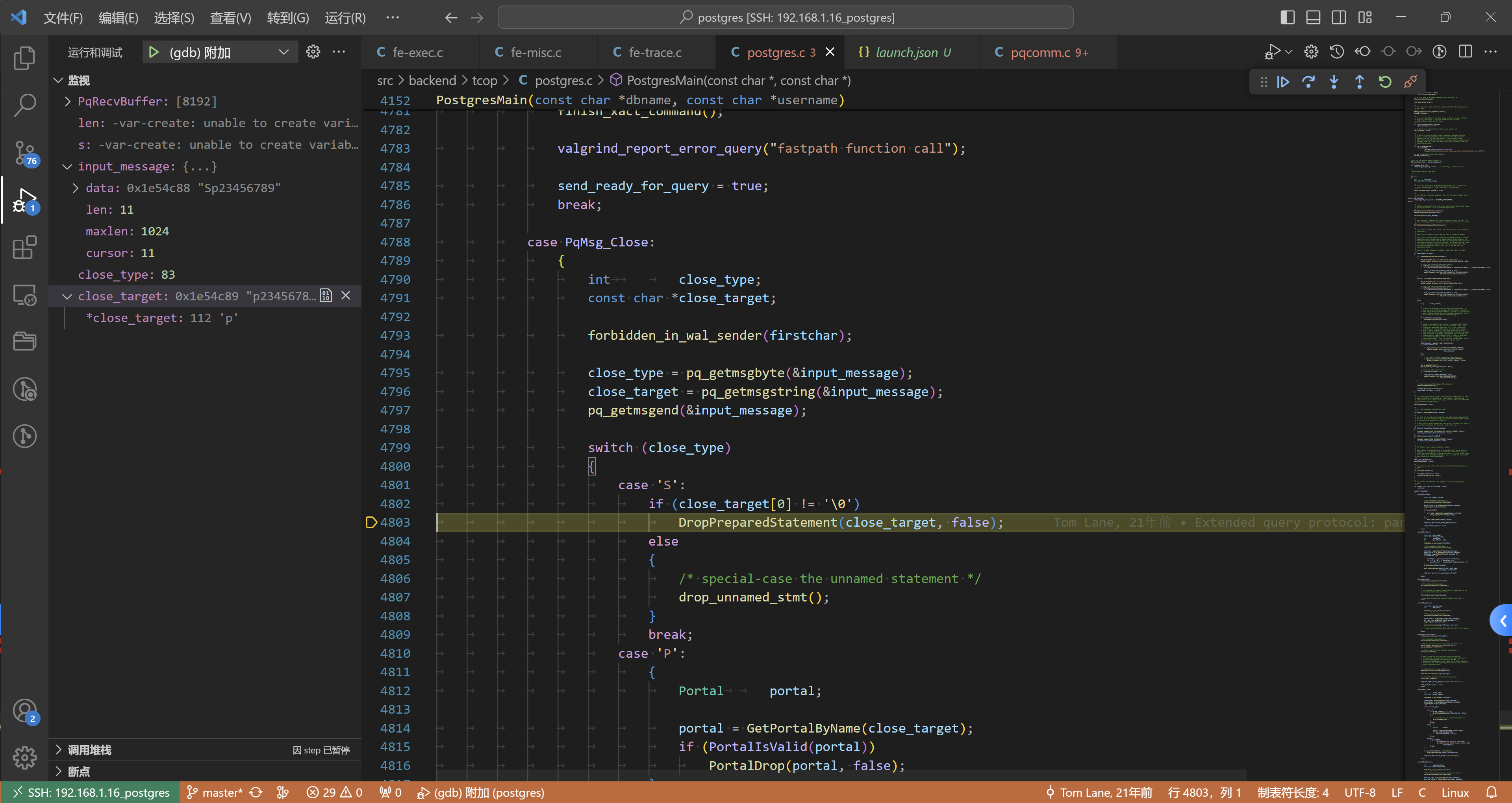
OK,至此 服务端解析完毕!
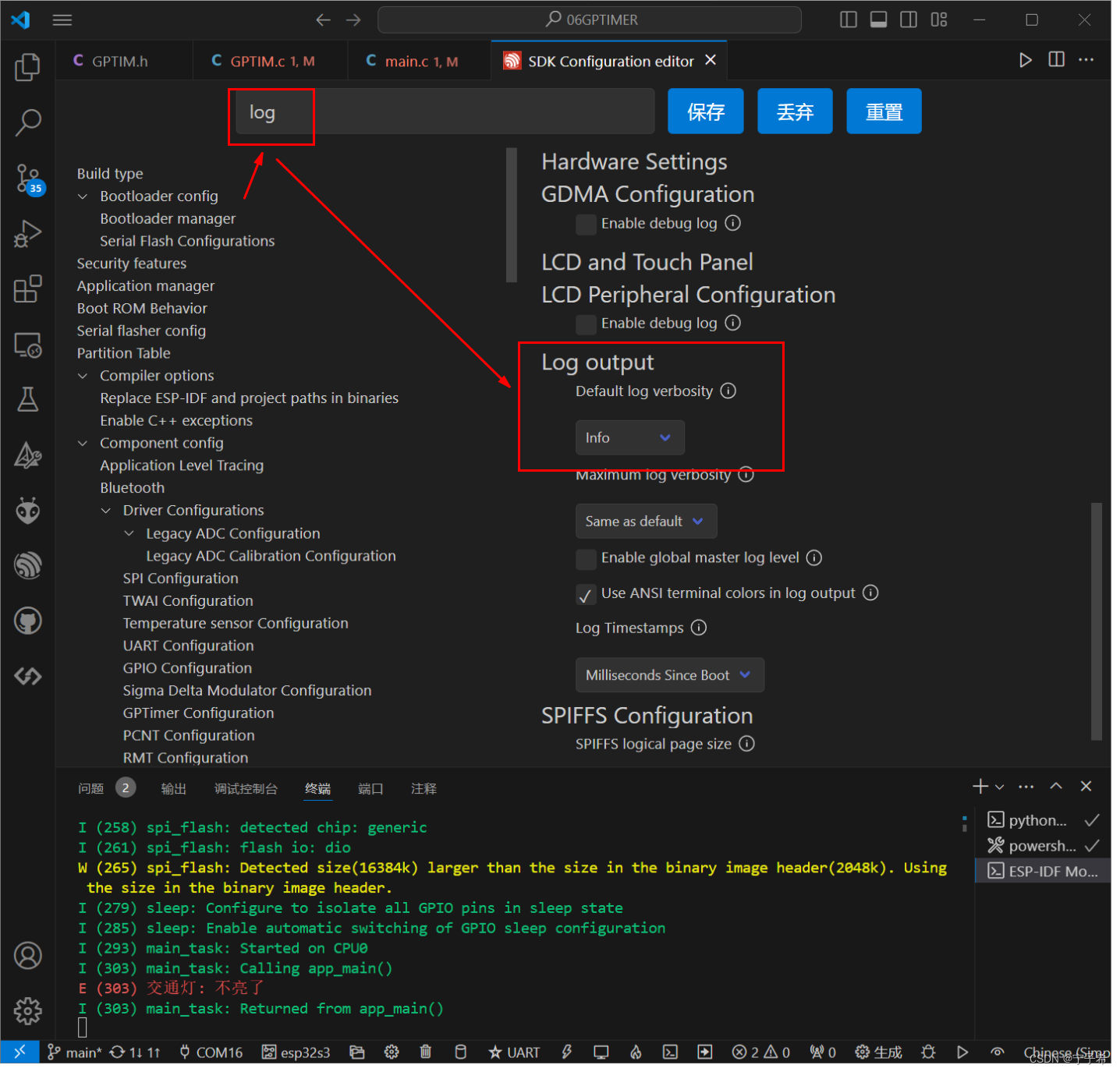
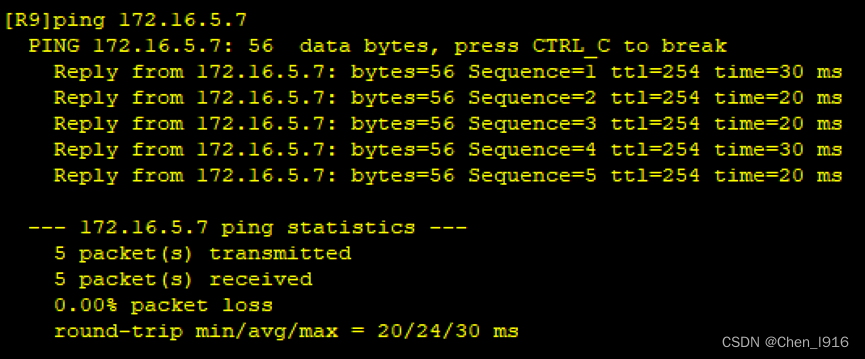





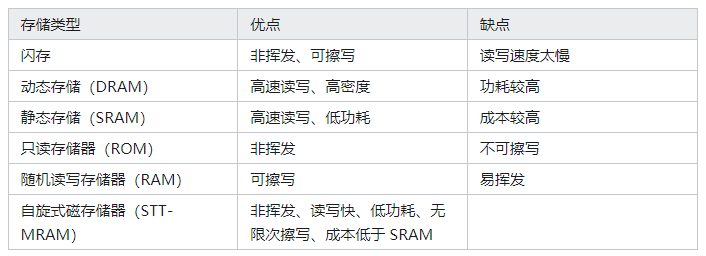
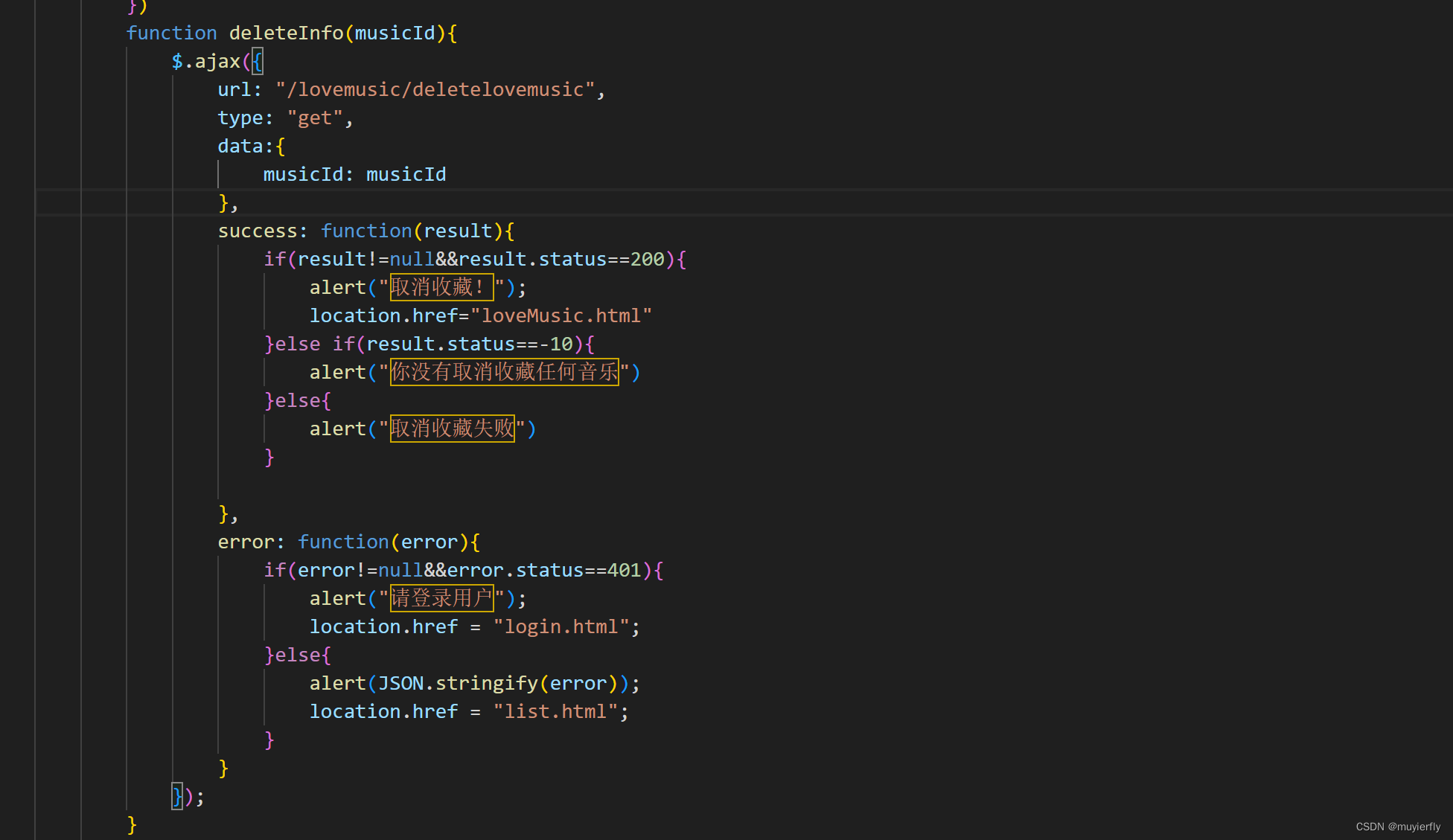
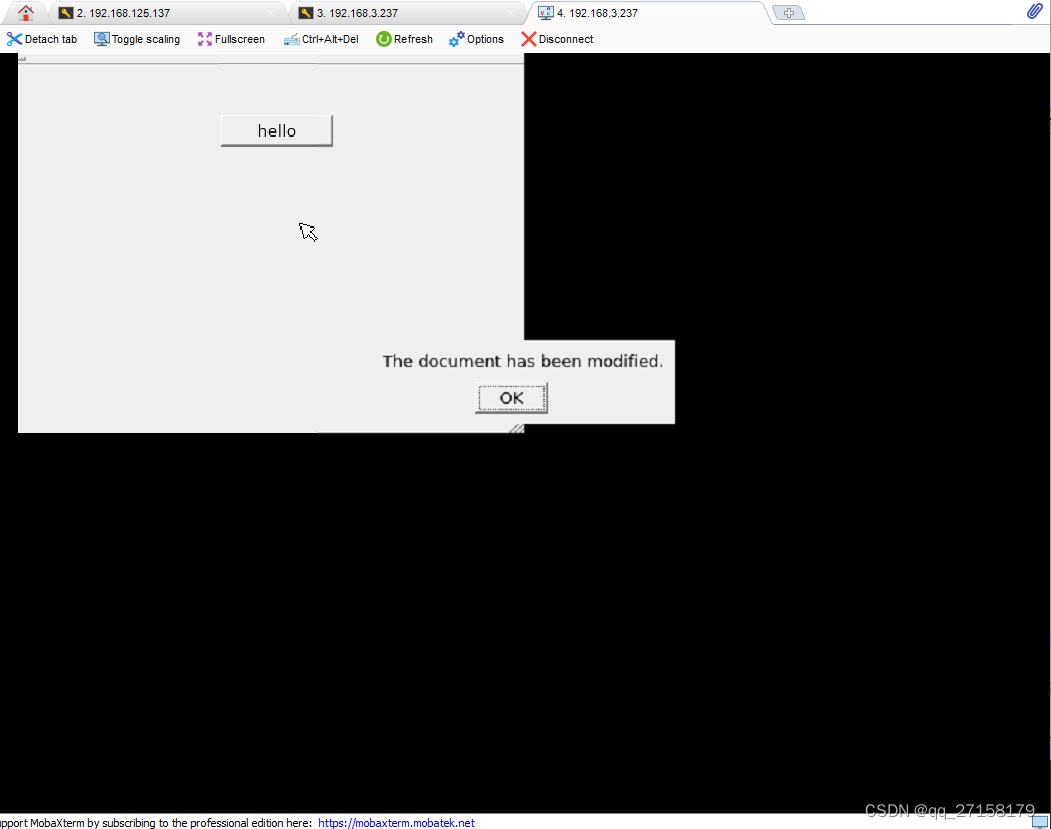

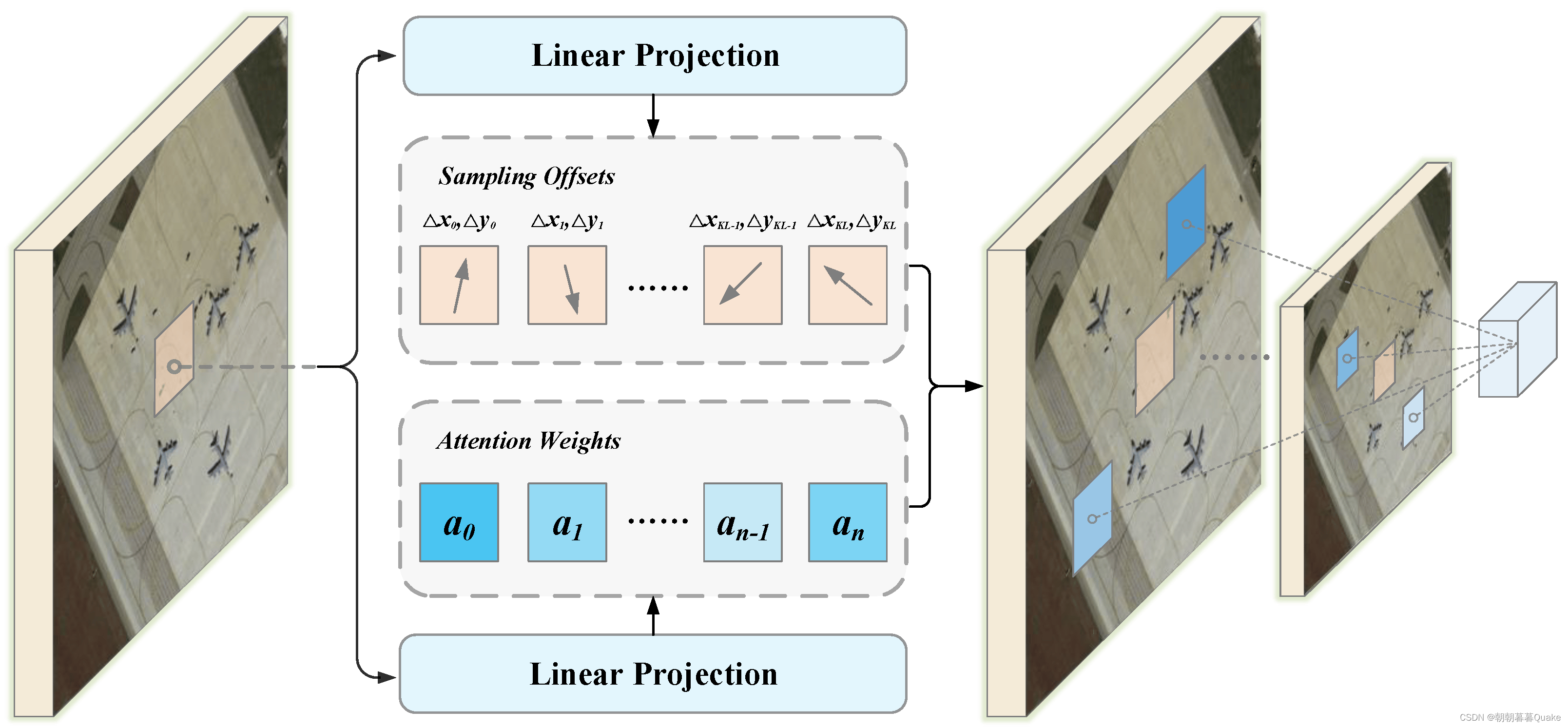

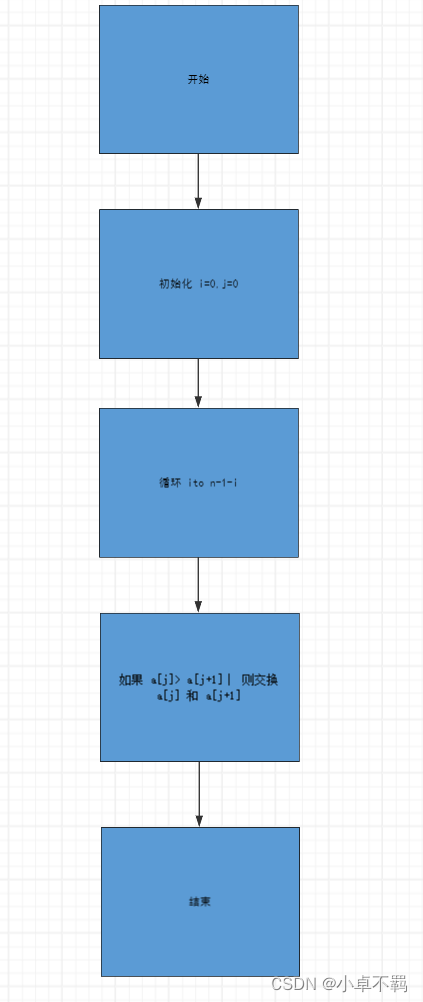

![[spring] Spring Boot REST API - CRUD 操作](https://img-blog.csdnimg.cn/direct/a43ca8b7a0264fd582599bded5a15f22.png)
